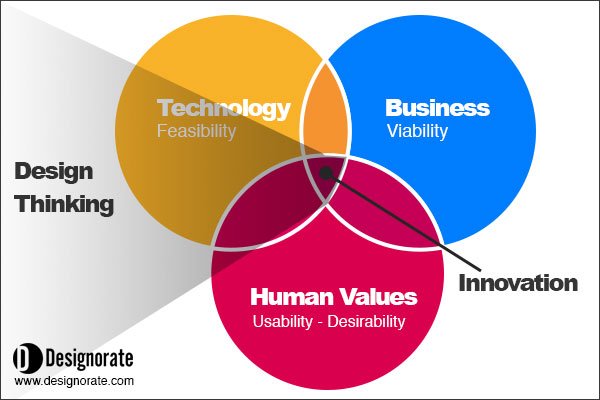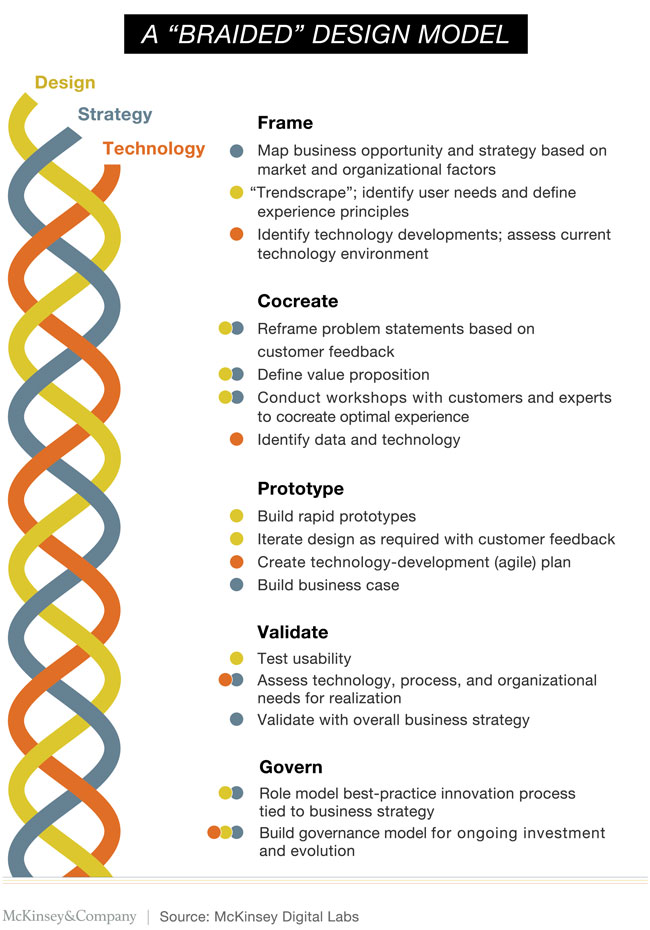Why Companies Need to Apply Design Thinking
Until the moment of writing this article, many companies are still having a lack of understanding the notion of design thinking. I believe this may be a result of two main factors; the first one that is many companies still don’t fully acknowledge to the broader role of design in business, and second is that design thinking is more perceived as a social innovation tool rather than a passway for successful profitable business–thanks to the IDEO promotion of the term design thinking.
Back to the main definition of design thinking, the term was first coined to Peter Rowe, a Professor of architecture at Harvard School of Design, as “account for the underlying structure with those rather private moments of ‘seeking out,’ on the part of designers.” Kees Dorst defines it as the practice that can be used to solve problems with a broader approach using professional design practice. Finally, Tim Brown, IDEO, defines design thinking as the usage of designer’s methods to address people’s needs with solutions that are technically feasible and business viable.
Related articles:
- Why Brainstorming is a Waste of Time and What is the Alternative
- Why Some Companies Reject Design Thinking and How to Handle it
Based on the above definitions. we can see two main characteristics of design thinking process (see Design Thinking Guide: What, Why and How); the design is perceived from a top strategic level in organizations and take part of building a design-driven business, and the application of design thinking aims to add values to business with considering the consumer needs. So, what are these values? Design researchers have investigated the benefits that can design thinking add to the business and come across a number of proven benefits that are aligning with many of today’s successful examples.
Building a Consumer-Driven Business
All the design thinking process models aims to achieve one goal; build a consumer-centered business that focus on addressing the people needs, which can be a potential added-value in competitive markets. Applying the design thinking in developing new products or improving existing products links between three main targets; user desirability, technical feasibility, and business viability.

According to McKinsey Group, creating a design-driven business helps companies to engage with their consumer. Their design model depends on three main elements; understand the consumer, bringing empathy into the organization, and combining both design, business strategy, and technology.

In their “Braided” Design model. the three elements blind through the design process of five main stages:
- Frame includes mapping the business opportunity, user needs, and technology environment
- Cocreate reframes the problem, identify the value proposition, and identify the data and technology
- Prototype develops the prototype, iterate the design based on the customer feedback, create the technology development plan,
- and build the business case
- Validate test the product usability, assess the technology, and validate the business strategy
- Govern build the best-practice innovation process, build the model for ongoing investment and evaluation
Design Thinking Drives Innovation
In his report about leading the UK economy through design and innovation (Cox Review of Creativity in Business: building on the UK’s strengths). Sir George Cox defined the design process as the bridge that turns creative ideas into innovative products that can add value to the market and economy. Nowadays, the market competency becomes aggressive that companies need to build innovative products that can make a difference in the market. This can be achieved through different types of innovation as follows:
- Sustaining innovation – most of the innovation happens here as the companies keep improving existing products to solve problems and add more values
- Breakthrough innovation – this type includes changes in an existing product that lead to significant impact on the market
- Disruptive innovation – this type introduces new products that later lead the market as defined by Clayton Christensen in his book, The Innovator’s Dilemma

Companies can achieve the above types of innovation by applying design thinking process to developing new products or improving existing ones. For example, IKEA applies an empathic design process that involves traveling to consumers’ places and investigate their needs. Apple is another example for innovative companies that apply design thinking within the organization to create new offering for their consumers
Design Thinking Fuels Brand Strategy
Design thinking is part of a larger umbrella of design management discipline which involves linking between design and business and look at design from a wider perspective of business approach. In her book, Design Management: Using Design to Build Brand Value and Corporate Innovation, Brigitte de Mozota categorized design contribution inside organizations into three domains:
- Operational design involves design tasks such as creating graphic design materials, designing products, and digital user interfaces
- Functional (tactical) design involves the design process such as arranging the cooperation between departments and different stages of the design process
- Strategic design involves looking to the design from a strategic perspective that links between the company strategy and consumer needs such as building the company brand and reflecting it to the above two types of design inside the organization (check Why Design Thinking Can Contribute to a Growing Business)

Starbucks is a good example of a company that uses design the reflect the brand image. In order to maintain the brand strategy over the organization, the company has developed a detailed guidance for the designers to make sure that the company image is consistent.
As a result of the above benefits, companies are able to achieve even more advantages. For example, it is proven that innovation can have a positive impact on the company competitiveness and profitability. The value that innovating new products or improving existing offering can help companies to improve its position in the market. This advantages can be also supported by the brand value which both can be achieved by applying the design thinking process and applying design from a strategic level.






